Gangwon Do, also known as Kangwon Province, has Chuncheon as its capital city. Before the division of Korea in 1945, this part of South Korea and its North Korean neighbor constituted a single province, as depicted on the map below.
Gangwon Province is bordered to the west by Gyeonggi Province, to the south by the provinces of Chungcheon and Gyeongsan, and to the east by the Sea of Japan. Its northern boundary is demarcated by the Military Demarcation Line, separating it from North Korea’s Gangwŏn Province.


The province’s landscape is predominantly characterized by the Taebaek Mountains, and it was historically one of the less populated areas on the Korean peninsula. This may account for the limited quantity of furniture that exists today, as well as the relative scarcity of diversity in construction and design in traditional Bandaji.

Bandaji from Gangwon Province are relatively easy to identify. The average dimensions are approximately 84cm x 90cm x 40cm. The top, sides, and bottom panels extend all the way to the front, creating a distinctive frame around the front of the bandaji. This characteristic is a common feature on chests from Gangwon Province and is rarely found on bandajis from other provinces.

Top, sides and bottom panels are extended all the way to the front and formed a frame around the front of the bandaji. This is a typical feature on chests from this province and is never seen on bandaji from other provinces.

Private collection

Private collection

Pine wood, iron fittings.
H. 83cm, W. 93,3cm, D. 41,5cm.

Pine wood, iron fittings.
H. 69,5cm, W. 87,5cm, D. 37cm.

Pine wood, iron fittings.
H. 80cm, W. 95cm, D. 42cm.

Late 19th century.

Late 19th century.

Collection: Cheonan Museum. Chuncheong Do province.
This framed type bandaji is typical from Gangwon province however the central South gate motif is usually used on northern pieces from Pyongan province.
The top panel was joined to the side panels using a clearly visible tenon and mortise construction.
Typically, inside the chest, there are three drawers arranged side by side at the top, located just under the top panel. These drawers were designed for storing valuables and small accessories.


The wood used was primarily pine, which comprised the majority of the chest’s construction. In contrast to other regions on the peninsula, the wood was not always stained to a darker color, and the final appearance of the pine could be a light brown, as depicted in some photos.
METALWORK DESIGN



Gangwon Province is mountainous, which made transportation inconvenient and trade with other areas challenging. As a result, metalwork in the region did not develop significantly. Although some metalwork is large in size, it is relatively thin and appears noticeably less refined compared to that of other regions.
The hardware displays a wide variety of auspicious motifs. The central hinges, which connect the front opening panel to the bottom panel, consist of two swallowtail-design plates (symbolizing beauty) and one central gourd-shaped plate. The gourd-shaped central hinge symbolizes good health.


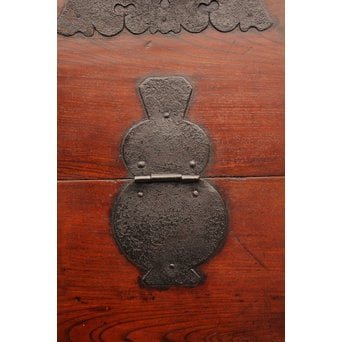
The plates under the top pullers are adorned with a bat design. The central lock plate is also crafted with the swallowtail design.
The bat pattern seen on the bandaji door is commonly used as a symbol of fortune in the Chinese cultural sphere. Bats are often regarded as auspicious symbols due to their association with good fortune and prosperity. Additionally, because of their prolific reproductive ability, they also symbolize fertility and the blessing of having sons
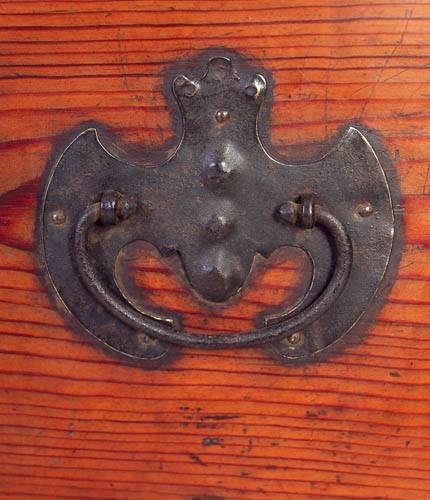



On the lower part of the chest, three large “Rhombic” plates or belly button-style plates are positioned under the central hinges. These plates serve a purely decorative purpose. Similarly, there are small flower-shaped “Gwangdujeong” ornaments, three on each side, which also serve a decorative function.
Flowers symbolize beauty, including beautiful things, women, and splendid times. Patterns featuring various flower shapes are often chosen based on human desires or hopes, and they are used to express wishes for blessings such as harmony, happiness, fertility, and the birth of many sons and daughters.

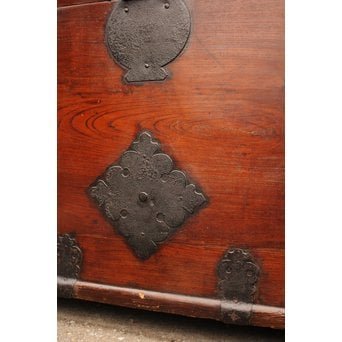

Other motifs may include the Lotus (symbolizing birth and creation), chrysanthemums (representing a productive and fruitful life), and clouds (in the past, people believed that when they accumulated enough good deeds in this world, they would ascend on clouds to the sky and become a human Buddha in the next world).


Early 20th century. H. 80cm, W. 94,5cm, D. 43cm.
Collection National Museum of Korea.

Early 20th century. H. 83cm, W. 94cm, D. 40,5cm.
Collection National Museum of Korea.

Collection: Old Story Antique Furniture, Korea.



Korea, Gangwon Provence, 19th century. The rectangular chest standing on a short base with a waisted apron with iron hinges, plates, and handles. with two panels at the front joined by two swallowtail hinges and a central gourd-shaped hinge. The opener panel is latched to the roof of the chest by a front locking swallowtail plate, flanked by flower shaped plates down the side. The lower panel is fitted with metal joints along the side and a central floral plate. Each side with a handle. Dimensions: 93 x 96 x 41.4 cm.
Auction: Galerie Zacke, Vienna, Austria. January 18, 2024.




Another distinctive design from this province can be observed in a chest with an elongated top panel. In some instances, the front opening did not extend entirely. These bandaji feature limited, simple metalwork designs.


Frederik R. Weisman Museum collection. Minneapolis. University of Minnesota.


Some bandaji also showcase extended raised top panels with, sometimes, small drawers on the upper front part and an opening panel in the middle. These chests were occasionally constructed with elaborate legs.

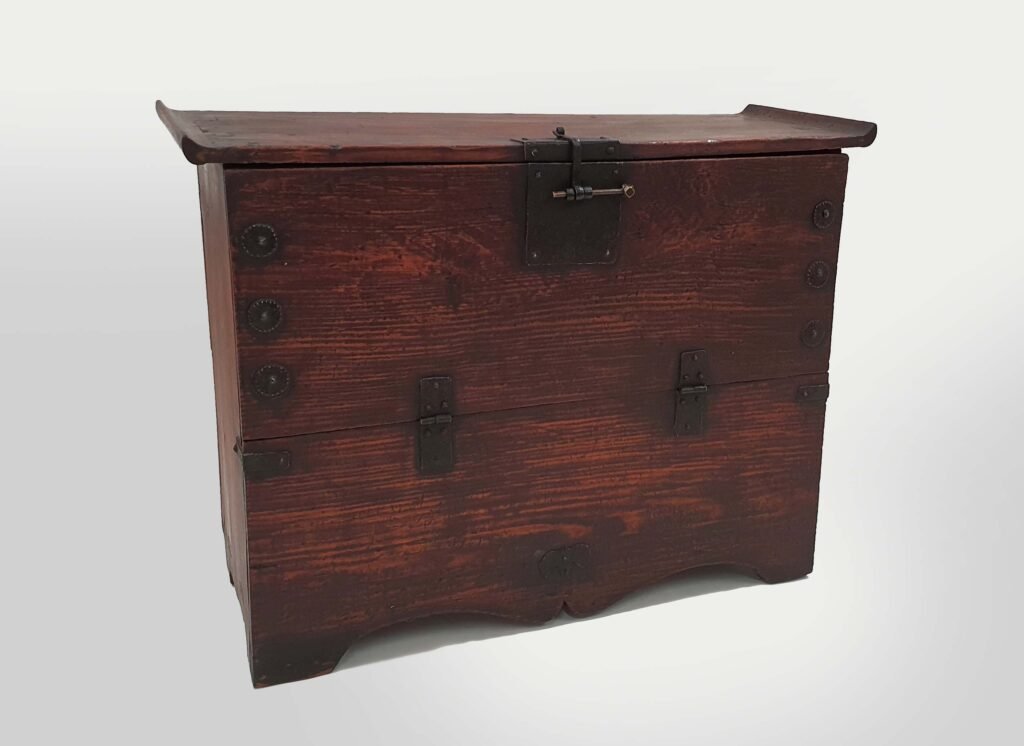
H. 58,8cm, W. 78,5cm, D. 28,4cm. Collection: Sokcho City Museum.

Red pine wood, iron fittings, oil finish. With three drawers in a bottom compartment. Gangwon Province, Korea. Mid 19th Century.
H. 106 cm, W. 106 cm, D. 46 cm. Collection: “ANTIKASIA“
What makes this chest unique:
The condition which is perfect, no restoration. A very thin red pigment lacquer has been applied on top of the wood.
The origin. Coming from Gangwon province in the eastern part of the Korean peninsula. Furniture production in this province was limited as this remote area was not very populated.
The overall design. It is the only Bandaji we saw with a drawers bottom compartment, This chest is higher than common blanket chests. All fittings are original and plates with their irregular shapes show clearly that they were handmade.

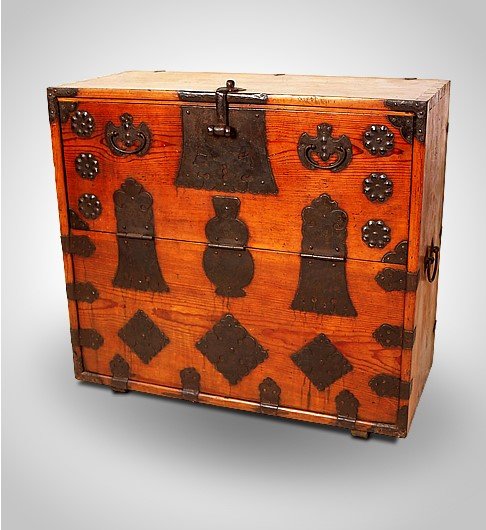
thanks for including my bandaji bought at gallery Zacke, great post, very informative as always!
You are welcome.